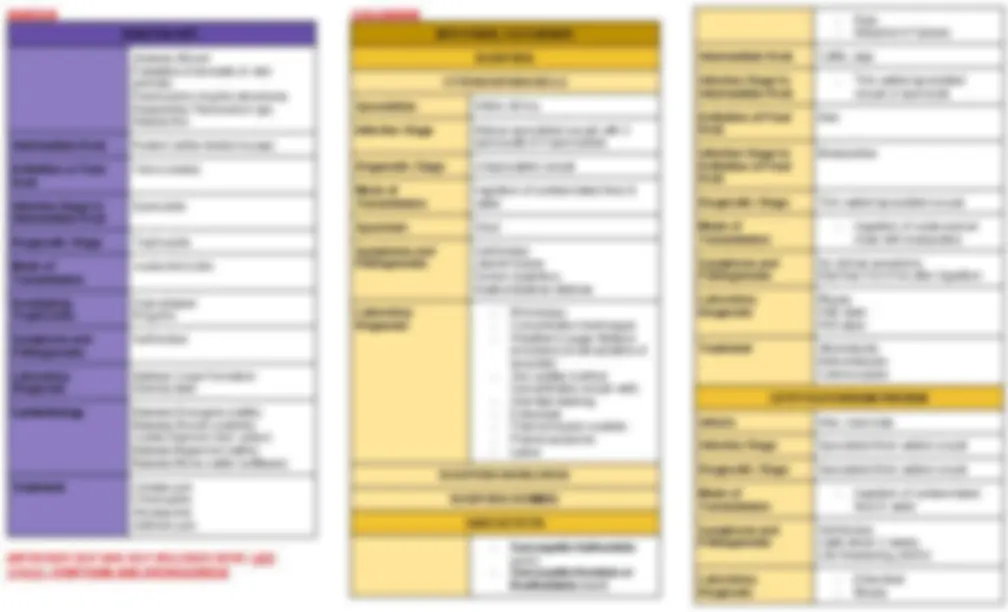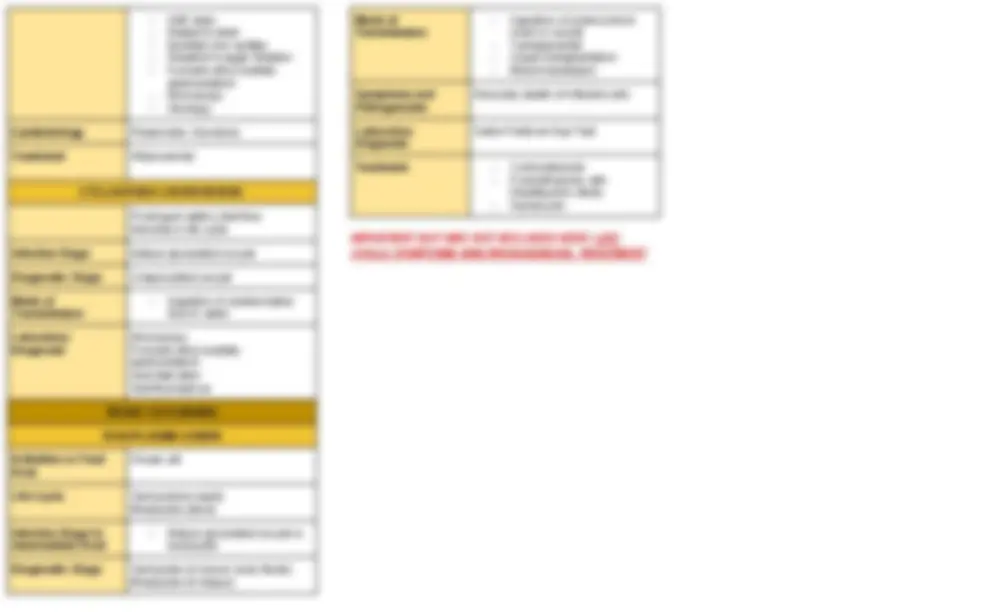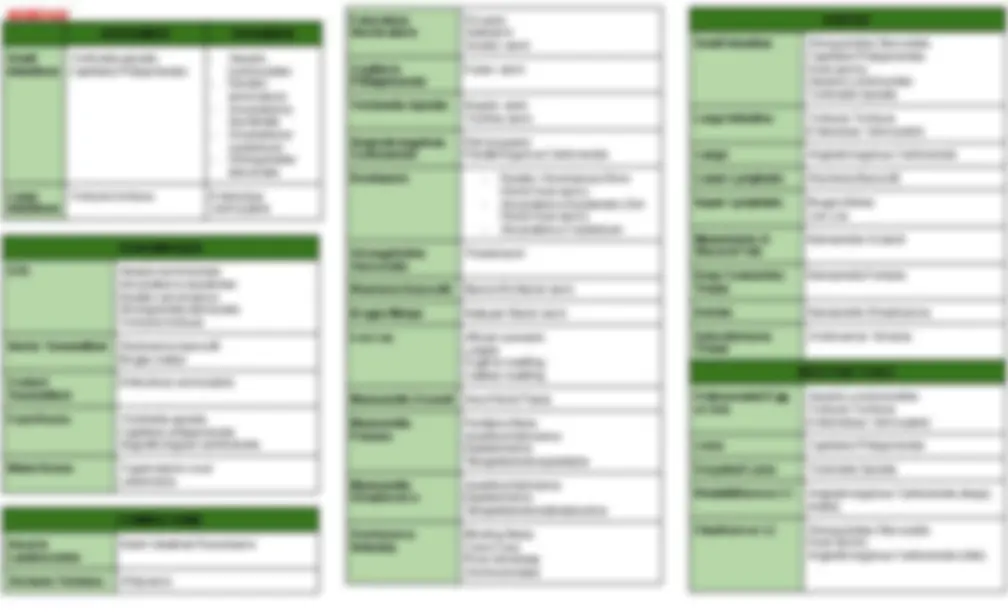Download [CLINICAL PARASITOLOGY] Apicomplexa (Babesia, Coccidians), & Nematodes and more Study notes Parasitology in PDF only on Docsity!
APICOMPLEXA
APICOMPLEXA
Intermediate Host Man Infective Stage to Intermediate Host Sporozoite Habitat in Man Liver, RBC Definitive or Final Host Mosquito (Female Anopheles) Infective Stage to Final Host Gametocyte Habitat in Mosquito Digestive Tract PLASMODIUM FALCIPARUM PLASMODIUM VIVAX PLASMODIUM MALARIAE PLASMODIUM OVALE Ring Forms - Infect young & old RBC slightly enlarged - Infect young RBC but enlarged - Infect old RBC
- Reticulocytes (young RBC) - Infect young RBC
- Delicate small ring form - Signet ring - Smaller ring
- Multiple ring forms in single RBC
- Signet ring
- 2 chromatin dots - Heavy chromatin dot - Heavy chromatin dot (Bird’s eye)
- Marginal forms (accole/applique) - ⅓ of RBC diameter - ⅛ of cell - Fimbriation
- Finger-like Developing Trophozoite - Ameboid
- Compact
- Giemsa stain (reddish orange)
- Cytoplasmic content (eosinophiliic)
- Nuclear content (basophilic)
- Ameboid
- Large chromatin
- Band-shaped
- Basket form
- Smaller RBC
- Non-ameboid
- Ring-shaped Schizonts - 8 to 36 merozoites
- Most prevalent in philippines
- Presence indicates severe malaria
- 12 to 24 merozoites
- Most prevalent worldwide & philippines
- Hypnozoites dormant
- Brown pigment
- 6 to 12 merozoites
- Rosette or fuit pie appearance
- Flower-like
- 4 to 12 merozoite
- Hypnozoites dormant
Gametocyte - Microgametocyte (sausage, diffuse chromatin) - Microgametocyte (round, surrounded by halo, pink to purple)
- Microgametocyte (smaller than Vivax) - Microgametocyte (smaller than Vivax)
- Macrogametocyte (crescent, compact chromatin)
- Highest number of nucleus
- Macrogametoyte (round, eccentric, chromatin mass, light brown)
- Macrogametocyte (smaller than Vivax)
- Round, fine granular
- Macrogametocyte (smaller than Vivax) Stipplings - Maurer’s Cleft (metabolism/genetic materials product)
- Schuffner’s Dots (hemoglobin metabolism product)
- Schuffner’s Dots - Ziemman’s Dots - Schuffner’s Dots
- James Dots Febrile or Erythrocytic Cycle - Malignant Tertian ( 36 to 48 hrs) - Benign Tertian ( 48 hrs) - Quartan Malaria ( 72 hrs) - Ovale Tertian ( 48 hrs) IMPORTANT BUT WAS NOT INCLUDED HERE: LIFE CYCLE
- H&E stain
- Masson’s stain
- Modified zinc sulfate
- Sheather’s sugar flotation
- Formalin-ethyl acetate sedimentation
- Microscopy
- Serology Epidemiology Resembles Giardiasis Treatment Nitazoxanide CYCLOSPORA CAYATENENSIS Prolonged watery diarrhea Meronts in life cycle Infective Stage Mature sporulated oocyst Diagnostic Stage Unsporulated oocyst Mode of Transmission
- Ingestion of contaminated food & water Laboratory Diagnosis Microscopy Formalin-ethyl acetate sedimentation Acid-fast stain Autofluoresence TISSUE COCCIDIANS TOXOPLASMA GONDII Definitive or Final Host House cat Life Cycle Tachyzoites (rapid) Bradyzoite (slow) Infective Stage to Intermediate Host
- Mature sporulated oocyst or bradyzoite Diagnostic Stage Tachyzoite (in blood, body fluids) Bradyzoite (in tissue) Mode of Transmission
- Ingestion of undercooked meat or oocyst
- Transplacental
- Organ transplantation
- Blood transfusion Symptoms and Pathogenesis Necrosis (death of infected cell) Laboratory Diagnosis Sabin-Feldman Dye Test Treatment - Corticosteroids
- Pyrimethamine with trisulfapyrimi-dines
- Spiramycin IMPORTANT BUT WAS NOT INCLUDED HERE: LIFE CYCLE, SYMPTOMS AND PATHOGENESIS, TREATMENT
NEMATODE
APHASMIDIA PHASMIDIA
Small Intestines Trichinella spiralis Capillaria Philippinensis
- Ascaris lumbricoides
- Necator americanus
- Ancylostoma duodenale
- Ancylostoma ceylanicum
- Strongyloides stercoralis Large Intestines Trichuris trichiura Enterobius vermicularis TRANSMISSION STH Ascaris lumbricoides Ancylostoma duodenale Necator americanus Strongyloides stercoralis Trichuris trichiura Vector Transmitted Wuchereria bancrofti Brugia malayi Contact Transmitted Enterobius vermicularis Food Borne Trichinella spiralis Capillaria philippinensis Angiostrongylus cantonensis Water Borne Trypanosoma cruzi Leishmania COMMON NAME Ascaris Lumbricoides Giant Intestinal Roundworm Trichuris Trichiura Whipworm Enterobius Vermicularis Pinworm Seatworm Society worm Capillaria Philippinensis Pudoc worm Trichinella Spiralis Muscle worm Trichina worm Angiostrongylous Cantonensis Rat lungworm Parastrongylous Cantonensis Hookworm - Necator Americanus (New World Hookworm)
- Ancylostoma Duodenale (Old World Hookworm)
- Ancylostoma Ceylanicum Strongyloides Stercoralis Threadworm Wucheria Bancrofti Bancroft’s filarial worm Brugia Malayi Malayan filarial worm Loa Loa African eyeworm Loiasis Fugitive swelling Calabar swelling Mansonella Ozzardi New World Filaria Mansonella Pertans Perstans filaria Acanthocheilonema Dipetalonema Tetrapetalonemaperstans Mansonella Streptocerca Acanthocheilonema Dipetalonema Tetrapetalonemastreptocerca Onchocerca Volvulus Blinding filaria Craw Craw River blindness Onchocerciasis
HABITAT
Small Intestine Strongyloides Stercoralis Capillaria Philippinensis Hookworms Ascaris Lumbricoides Trichinella Spiralis Large Intestine Trichuris Trichiura Enterobius Vermicularis Lungs Angiostrongylous Cantonensis Lower Lymphatic Wucheria Bancrofti Upper Lymphatic Brugia Malayi Loa Loa Mesenteries & Visceral Fats Mansonella Ozzardi Deep Connective Tissue Mansonella Pertans Dermis Mansonella Streptocerca Subcutaneous Tissue Onchocerca Volvulus INFECTIVE STAGE Embryonated Egg or Ova Ascaris Lumbricoiddes Trichuris Trichiura Enterobbius Vermicularis Larva Capillaria Philippinensis Encysted Larva Trichinella Spiralis Rhabditiform or L 1 Angiostrongylous Cantonensis (slugs, snails) Filariform or L 3 Strongyloides Stercoralis Hookworms Angiostrongylous Cantonensis (rats)














